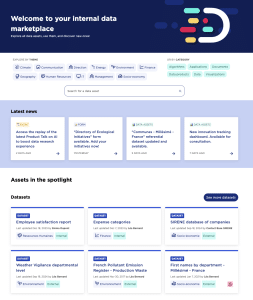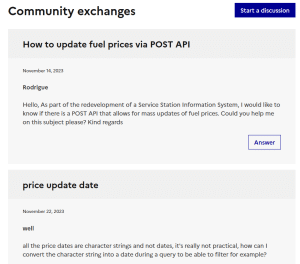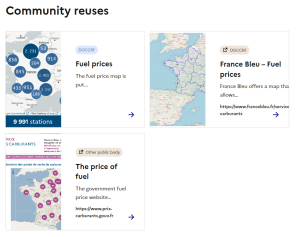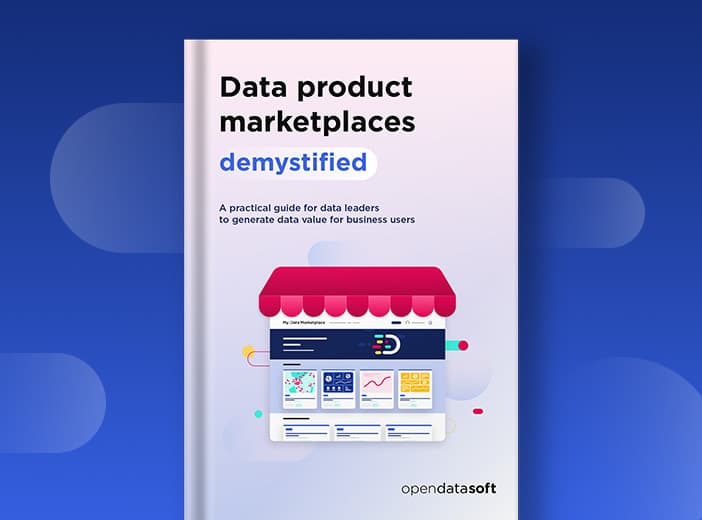Everything you need to know on data products for business users

It can be hard to understand exactly what a data product is, given the many ways that the term is defined and applied. To provide clarity this article provides a business-focused definition of a data product, centered on how it makes data accessible and usable by the wider organization, while creating long-term business value.
What is a data product?
Given the complexity caused by the multiple, different ways of describing what a data product is, we have opted for a definition that prioritizes simplicity, while remaining faithful to our mission to democratize data:
“A data product is a data asset that meets high standards around its presentation, readability, and quality in order to enable its consumption by a large number of users. To establish complete trust, it must always provide access to its source data and include a data contract specifying the product owner’s commitments through a SLA and terms of use, and be machine-readable to guarantee automated usage.”
What are the essential characteristics of a data product?
Here are the five main characteristics of a data product:
- Meets a specific, identified business need: a data product must address a specific, significant, and often strategic business need.
- Consumption-ready: A data product should be easy to discover, accessible, and, most importantly, ready to use for (often non-technical) target audiences. This means that it includes all the elements necessary to allow business users to consume the underlying data via tailored interfaces (such as tools, visualizations, and APIs). The source of the data must always be directly accessible to guarantee trust in its use and reuse.
- Impact at scale: A data product should be designed for a large user base, in order to generate maximum value in the organization.
- Continuous evolution and monitoring: A data product is not just a one-off report, but a data asset that is continuously monitored, updated, and improved.
- Governed through data contracts: a data product must be governed by contracts that provide SLAs for data quality, how it can be used, and access rights.
Why share your data products at scale on a data marketplace?
Creating data products is the first step towards maximizing business value from data, but it’s not enough. As with physical products, making sure they are visible and available in the right places are key success factors. While they can be shared through methods such as email, as Excel files, or through existing data management solutions, these approaches fail to drive business consumption at scale as they fail to deliver an engaging experience or context to data consumers, especially non-technical users. This means that this crucial audience is unable to use them with confidence, limiting opportunities to create value. At the same time, they fail to provide governance or control mechanisms for data teams, making their management complex and lowering trust in their usage.
To generate value, data products must therefore be easily accessible to business users through self-service and be effectively promoted to make them easy to discover. This is why data product marketplaces, which are designed specifically to aid the creation, promotion and consumption of data products at scale are particularly relevant. They play a central role in bringing together all stakeholders, including:
- Data consumers (business teams): A data product marketplace offers advanced search and contextualization capabilities, making it easier for end users to discover, access, and understand data products. To consume data with confidence, they need to have as much context as possible and have trust in the data they are accessing through a clear data contract. Data consumers also need to be able to leverage data directly, whether through visualizations, tabular views, or APIs, and easily interact with data producers in case of questions.
- Data governance teams: A data product marketplace provides essential tools for controlling, managing and assigning access to specific data, defining usage rules and measuring data product consumption. This ensures that the relevance and quality of data products is continuously improved.
- Data producers: a data product marketplace allows them to effectively promote their data products and enhance their value. With interactive features, producers can also gather valuable feedback from data consumers, allowing them to finetune the relevance and quality of the data shared, while ensuring its development and continued adoption.
What features of an Opendatasoft data marketplace support data products?
- Effective promotion through a dedicated storefront: Data producers can promote their products in an efficient and simple way, whether through a fully customized homepage or directly in the integrated data catalog:


- Powerful, AI-powered search: The data product marketplace’s integrated catalog provides an intelligent AI-powered search engine that allows consumers to find the right data in a single click, even in the case of incomplete or badly formulated queries. Users also benefit from automatic recommendations of data assets that are similar to the data product they are using, enriching their experience within the marketplace.
- Data consumption tools: unlike data catalogs, the Opendatasoft data product marketplace provides direct access to data, through tools and interfaces that have been designed to make data easy to consume intuitively through self-service, without requiring technical skills. This meets the needs of business users for immediate and independent access to the right data.
- Data preparation capabilities: Data producers benefit from advanced tools that help them transform their raw data and make it more accessible to end users. These data preparation tools are designed to optimize understanding and facilitate effective use of data products. For example, they can be used to replace text or terms in specific fields to make the data more understandable and accessible to a wide audience.
- Tools for measuring conversion and monitoring usage: the data product marketplace includes capabilities that allow data producers to continuously optimize the use and value of their data products. Data lineage provides a detailed view of which data products are being used, use cases and the audience consuming them. By analyzing the data conversion funnel, organizations can study user journeys and identify ways to improve the experience to maximize the adoption and use of data products.
- Product sheets and data contracts: the Opendatasoft data product marketplace solution enables organizations to create a product sheet associated with each data product and to integrate a data contract, which builds trust around data use by end users.
- Governance and access request workflows: Data consumers can easily request access to specific data products with one click in the Opendatasoft marketplace, thanks to intuitive access request buttons. Data producers can then manage these requests in a streamlined way via a centralized space. This process promotes large-scale consumption while ensuring secure governance and historical monitoring.
Taking a deep dive into data products created using Opendatasoft
Demonstrating the potential of data products, many Opendatasoft customers have already used our solution to create and share data products. Here we focus on two examples – the West of England Mayoral Combined Authority in the UK, and the Ministry of Economy and Finance in France.
Shaping a greener future
The West of England Mayoral Combined Authority was set up in 2017 to make decisions and investments that benefit people living in the west of the United Kingdom. To drive transparency, demonstrate the region’s economic strength to attract investment, encourage the shift to net zero and accelerate nature recovery, it has created a data portal that provides 90 datasets from the Mayoral Combined Authority, its partners and the unitary authorities it works with. This includes data on energy performance in buildings, access to green space, pollinator projects and information on how money is spent.
A key focus for the portal is the Local Nature Recovery Strategy (LNRS), the first published by an English local authority. As well as the LNRS itself, the portal contains an interactive toolkit. This data product provides an intuitive resource that helps farmers, landowners, businesses, local authorities, community groups and citizens to take effective action to restore nature and natural habitats.

Accessed through a drill-down map, users can zoom in to view specific, detailed areas, click to see current biodiversity levels and pictures of local species, as part of the objective of aiding nature recovery.
- As well as visualizations, the tool provides direct access to the source data to ensure transparency and trust, such as around key species found in the region:

- Users can see exactly when data was last updated, guaranteeing reliability:

- The producer is clearly identified, and data products can be subscribed to guarantee updates. Similar datasets are flagged to widen usage:

- Users can simply click to access relevant next steps and link directly to resources, such as available environmental grants and programs, driving action through data:

The French Ministry of Economy and Finance’s Fuel Prices data product
The Fuel Prices data product provides consumers and businesses with reliable, accessible and continually updated information on the price of fuel across France.
Key features include:
- The producer and the dedicated contact are clearly identified and contactable (by email) to answer questions from data consumers:

- There is an integrated discussion space so that consumers can share their feedback and questions related to the data product:

- Concrete cases of dataset reuse are highlighted to illustrate and encourage further use of the data product:

- A complementary view of the data product is offered in the form of a map, to maximize understanding by data consumers:

Thanks to careful packaging and a focus on quality, data is accessible and actionable by a large audience of data consumers, leading to nearly 130 million API calls and 700,000 downloads to date.
While we have shared examples from public data marketplaces, data products can equally be created and used internally to deliver business value. For more information watch our Product Talk webinar to discover other internal data product use cases and to learn best practices from our team.
Data products: a powerful, fast way to maximize data impact in your organization
Providing meaning and context to your data and making it fully understandable to a non-technical business audience is essential to ensuring it delivers value to the organization. The process of turning raw data into data products does require a time investment but is necessary to drive data consumption at scale by the business. This delivers a return on your investment in the data stack, as well as helping achieve wider business goals.
To succeed with data products, two complementary steps are essential – their creation and their promotion. A data product marketplace is central to both of these. While creating a data marketplace in-house may seem feasible, it is a complex and time-consuming process, requiring resources and expertise that few companies possess, particularly when it comes to long-term development and support. By contrast, a specialized, SaaS-based data product marketplace solution, such as Opendatasoft, is designed to address these challenges. It offers out-of-the-box tools tailored to your (and your users’) needs and provides scalability and flexibility that in-house development cannot match without heavy investment. It allows you to create value quickly, even when only focusing on just a few data products, by packaging and promoting them effectively so that they generate significant impact at scale within your organization.
Find out more in our Product Talk: Maximizing data value: How data products and marketplaces accelerate data consumption for business users

In today’s data-driven world, many organizations struggle to scale data consumption, with their data scattered across multiple systems, making it hard to access, understand, and leverage effectively. How can organizations transform this raw data into value, enabling it to drive decision-making, innovation, and AI adoption? This practical guide helps Chief Data Officers (CDOs) and data leaders to transform their data strategy and meet their goals by implementing self-service data product marketplaces.

Data product marketplaces empower businesses and data leaders with the ability to industrialize data sharing and consumption to create data value. We look at the key foundations you need to put in place to ensure your data product marketplace successfully generates value, increases usage and drives ROI.

In an increasingly data-driven world, understanding the differences between data, metadata, data assets, and data products is essential to maximizing their potential. This is because these interrelated yet distinct concepts each play a key role in driving digital transformation by facilitating data sharing and consumption at scale.
